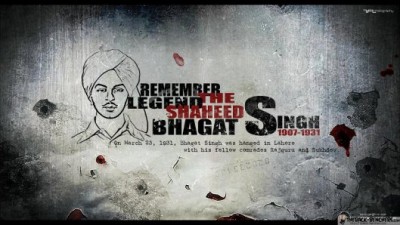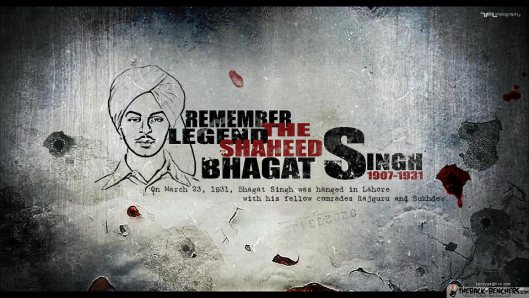Shelley Kasli
A new book on India’s most famous revolutionary who was hanged by the British on March 23, 1931, claims to have unearthed “hidden facts” showing that Bhagat Singh was not executed by hanging. Chaman Ahuja examines the facts revealed in the book.

In Punjab, the spirit of Bhagat Singh is rising again: preparations have started to organise big events to commemorate in a befitting manner the anniversary of his martyrdom. Besides a series of huge melas, rallies and processions, explosion of theatrical bombardment, a spurt of books and treatises and a plethora of political rhetoric, one may expect the occasion to open a Pandora’s box of controversies, old and new. In fact, a Chandigarh publisher, Unistar, blazed the trail by releasing a book in London (on October 28). For all one knows, its hitting the bookstands might prove the stirring of a hornet’s nest. Titled Some Hidden Facts: Martyrdom of Shaheed Bhagat Singh, it carries the subtitle “Secrets unfurled by an Intelligence Bureau Agent of British-India” (sic).
The real focus of the book is on the ‘hidden facts’ pertaining to the execution of Bhagat Singh. Indeed, the book is an attempt to provide new answers to the innumerable unresolved puzzles — e.g., why the unprecedented hanging of the three martyrs at night; why the dead bodies were not handed over to the relatives but cremated post-haste by the administration without the mandatory postmortem; above all, what was the place and nature of the ‘cremation’?
The way the ‘hidden facts’ have come to light is itself a story that is as questionable as it is interesting. The chief source of the startling information is a man who was a British toady — in fact, a most trusted secret agent of the British government. This man called Dalip Singh Allahabadi had worked as a gardener at Anand Bhawan, Allahabad, and had later acquired the dubious distinction of slapping Jawaharlal Nehru when the latter was leading a demonstration against the Simon Commission.
Kulwant Singh Kooner, the co-author of the present book, is the adopted godson of Allahabadi; he lives in Sinfin, Derby (UK). Allahabadi died in 1986 and the two never met again. Meanwhile, the godson had worked out a book based on the notes taken by him but, those being the days of the Emergency, his real father would not let him publish it; in fact, the father pretended that a publisher friend of his was interested in seeing it and he got the manuscript from Kulwant and destroyed it.
Only after the death of his father, in 1992, Kulwant started the process of working again on such material as his memory afforded; he wanted a movie to be based on Allahabadi’s version of the story, but no one took him seriously. And then he met the co-author, G S Sindhra, a homoeopathic doctor, who put in a lot of additional information into Allahabadi’s narrative through research in the British Library, London.
According to Allahabadi — as recalled by Kulwant and presented by Sindhra — the ‘execution’ of Bhagat Singh, Rajguru and Sukhdev marked the execution of a conspiracy code-named “Operation Trojan Horse”, which, in effect, facilitated the pacification of the British officers in general and the prospective in-laws of the late J P Saunders in particular. Accordingly, Bhagat Singh and his associates did go through the formality of ‘hanging’ but only to the extent of breaking their necks; semi-conscious, they were taken to the Lahore Cantonment where the ‘Death Squad’, comprising Saunder’s family, shot them to quench their thirst for revenge.
Since doing all this during day time could have invited a violent reaction from the people, the ‘execution’ was performed at night; for the same reason, the bullet-ridden bodies were neither sent for postmortem nor handed over to the relatives. Instead, most surreptitiously, these were taken in a lorry to a pre-fixed isolated place on a kutcha-road (6 miles away from Lahore, on the right bank of the Beas where it meets the Sutlej) and burnt to ashes. And, to put the people on the wrong track, some flesh and bones were half burnt and buried on the western bank of the Sutlej, near Hussainiwala. Two Indian agents were sent to Lahore to pose as volunteers and tell the Congress people that they had seen at Ganda Singh Wala a big burning pyre from a distance.
Believing the story, some people (including Bhagat’s sister Bibi Amar Kaur) reached the ‘hot’ spot, dug up the flesh and half-burnt bones (plus one big broken but uncharred bone which they surmised must have been the arm of Bhagat Singh, the tallest of the three) that lay buried there, and took these back to Lahore where the half-burnt stuff was ‘properly’ cremated on the bank of the Ravi in the midst of sloganeering crowds, all in tears.
This was precisely what the ‘Operation Trojan Horse’ meant to achieve — the British way of denying the martyrs the honour of a glorious farewell by the people.
EXCERPTS
‘Operation Trojan Horse’
The British Authority of India was frustrated with the rising popularity of Bhagat Singh and his ways of exploiting the Government machinery — the courts and Press Newspapers for propagating his ideology. And when on 8th March 1931, Bhagat Singh gave his consent to Bejoy Kumar Sinha to file a mercy petition to the crown on his behalf after a prolong discussion between two friends, the same racial group of some English officers felt that their ambitions could not be fulfilled. So they made a secret plan according to which they send a team of some officers to Delhi and put up the pressure on Lord Irwin and thus getting his silent consent to carry on their plan named “Trojan Horse”. So, on 23rd March, 1931, the “Trojan Horse” plan was fully implemented and after a fake drama of execution the three young men were brought unconscious to a secret place in the Lahore Cantonment where they were shot dead by “the death squad”.
To conceal the whole episode, the authorities had made arrangement for cremation at some secret place on the right bank of the Beas and the Sutlej convergence. On the other hand to divert the public attention, the authorities had made arrangement for another pyre at Hussainiwala.
They were also afraid of postmortem which would reveal the presence of bullets in the dead bodies and the same was the case with the ashes. By doing so, the Englishmen had fulfilled two jobs. One, to pacify the anger of the relatives of Saunders and on other hand they hoped to befool Indians who would pay tributes at the wrong place and would worship the wrong bodies remains.
………
After some days he (Dalip Allahabadi) got a chance to go through the secret reports of Lahore agent in which it was revealed that on Monday 23rd, three convicted were hanged in Lahore jail at 7.15 p.m. but they were not allowed to die. They fell unconscious after a few seconds of hanging and the unconscious bodies were removed to Lahore Cantonment on a big lorry which was full of wood.
One report also revealed that the leader among the convicted (Bhagat Singh) gained some consciousness after some time. Then the P.A. to the Governor of Punjab, the father-in-law of Saunders, was allowed to shoot at the convicted. He fired bullets on the head and chest of Bhagat Singh and others.
Then the dead bodies were taken to the selected site on the right bank of the Beas-Sutlej river, where the last rites were performed, according to the religious faith of the convicted. The reports also mentioned about the happiness and satisfaction of the British community in Lahore, on the work done by the death squad.
Mr V.N. Smith Superintendent of Police (political) Criminal Investigation Department, Punjab, wrote in his memoirs on “The Saunders Murder Case” being preserved in a microfilm at the British Library London, — “Normally execution took place at 8 am, but it was decided to act at once before the public could become aware of what had happened” — He further wrote that “at about 7 pm shouts of Inquilab Zindabad were heard from inside the jail. This was correctly, interpreted as a signal that the final curtain was about to drop”.
At 7.15 p.m. all the three youngmen were hanged, but, as earlier described, their hanged bodies were removed before their souls departed. All the three were unconscious with broken neck. The man who performed the duty of hangmen was arrested immediately and, according to Dalip Singh’s information, was slain in the room where the dead bodies were usually kept for identification after the execution. The slain dead body of the hangman was put into the big lorry along with three unconscious heroes of Mother India. (Courtesy: greatgameindia.wordpress.com)
Some Hidden Facts: Martyrdom of Shaheed Bhagat Singh
Published by Unistar Books, Chandigarh.
Pages 183. Rs 295






















